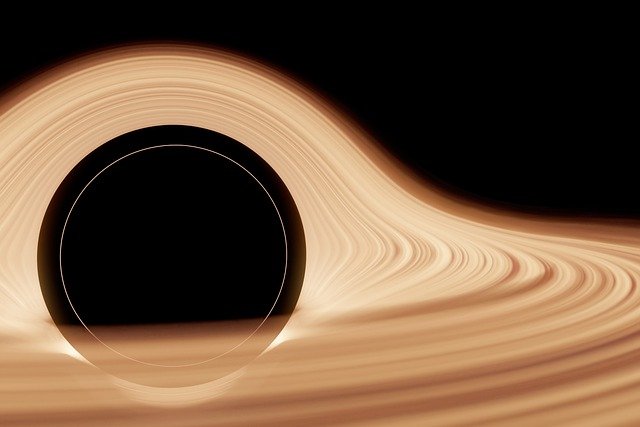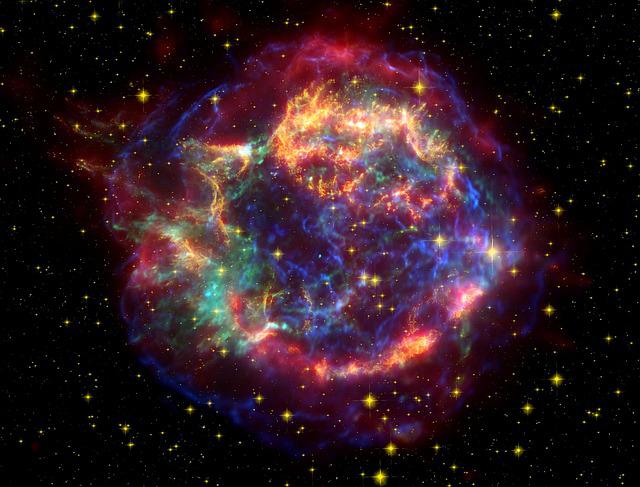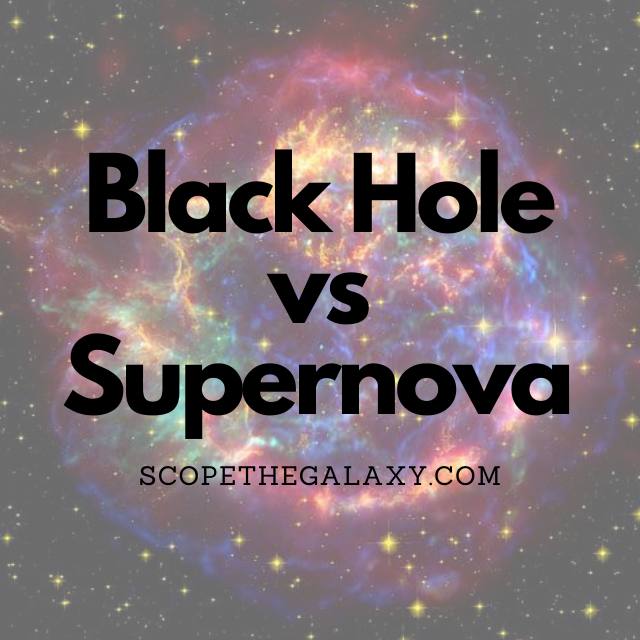*This post may contain affiliate links. This means we may make a commission if you purchase an item using one of our links*
Black holes are the by product of a supernova explosion, particularly those that are 3+ solar masses in size so, even if the two are connected in the sense that they both form when a star is essentially dying, you wouldn’t be able to classify them within the same celestial bracket.
Black holes are amongst the darkest entities in the universe whilst supernovae are so bright that they can even outshine entire galaxies. Black holes are so dense that light cannot escape its grasp. They’re very cold being just shy of absolute zero whilst a supernova can burn at a 1 billion+ degrees Celsius.
The main difference you could say is that a black hole is the darkest and densest entity in our universe whilst supernovae are amongst the brightest most grandiose explosion in our universe.
Throughout the remainder of this article I’ll be going over the similarities and differences between black holes and supernovae so, continue reading if you want a more thorough breakdown of both entities.
What Is A Black Hole?
Table of Contents

A black hole is created when a large star about 3 solar masses large collapses below its Schwarzschild radius causing a supernova explosion. The density of the star creates a massive gravitational pocket and pulls everything within its vicinity into it.
The edge of a black hole is known as the event horizon and once something crosses this point, there is no escape. The gravitational pull of a black hole is so immense that even light is sucked inside.
All objects pulled in are subjected to an unimaginable crushing gravitational force as they are pulled toward the super dense end point of the black hole known as the singularity.
Black holes can be split into a variety of different types such as a supermassive black hole, intermediate mass black hole, and stellar mass black hole.
Stellar mass black holes are formed as described above by the death of a large star collapsing inward on itself. An intermediate mass black hole is slightly larger than a stellar mass black hole and may form be acquiring stars within its reach although not many have been discovered so little is still known about them.
A supermassive black hole can be found at the center of a galaxy and consumes stars and smaller black holes in order to obtain its massive size – millions of times larger than our Sun.
What Is A Supernova?

Black holes are what remains after a supernova explosion occurs, which in turn means that this explosion is the process followed when a star is dying. It will then be classified as a type 1 supernova if it leaves no hydrogen line emissions in the spectra and type 2 which would be an explosion roughly 15 times the mass of our sun and does produce hydrogen line emissions.
There are two ways that a supernova explosion can form.
It can either be via a white dwarf in a binary star system that accumulates too much energy from its companion star causing it to explode or when a larger star runs out of nuclear fuel and collapses under its own gravity, leaving behind the bright and grandiose remnants of this explosion many times brighter than even its own galaxy.
As stated above supernovae are generally split into 2 types, a type 1 supernova or a type 2. Type 1’s are then further split into 1 of 3 subcategories, whether Ia, Ib or Ic.
A type 1a supernova is the most commonly observed in outer space and acts like a candle light to help us observe distance across the deep unknown.
These are theorised to form after a white dwarf, likely in a binary star system, exploding due to the over consumption of energy from its companion. Type Ia’s have a strong silicon absorption line near its maximum luminosity whilst producing no hydrogen at the same time
Type Ib’s are formed after a large star collapses under its own core gravity where the outer region of the stars hydrogen is stripped away, leaving behind only second layer of helium that remains.
Type Ic’s lack both the hydrogen and helium layer when they explode, although the difference here has been debated as not being significant enough to differentiate a type Ib from a Ic.
Type 2 supernovae are formed when a star between 8 – 50 times the Sun’s mass collapses into itself and causes a huge explosion either producing a neutron or a black hole if the materials left behind exceed 3 – 4 solar masses.
In essence anything above 20 times the size of our Sun can potentially result in a black hole whilst a star that is 1.44 solar masses or between 10 – 20 times the mass of our Sun would produce a neutron star instead.
What Would Happen If A Black Hole Ate A Supernova?
If a black hole were to consume a supernova (which is very very unlikely), there would be two likely scenarios that occur. One where the explosion would be inside the black holes event horizon and the second would be when it isn’t.
If the supernova is inside to the event horizon of a black hole, despite the supernova being the brightest entity for a brief moment in time, black holes do not allow even a single inch of light freedom in its domain therefore, it would essentially drown any form of light when in its presence.
Within the event horizon, the supernova will basically bend around the black hole and steadily be drawn into the gravity of the black holes which have among the strongest gravity in the universe, particularly when measured at the singularity.
On the other hand, if the black is outside the event horizon, the light would bend around the black hole distorting your view of it. This is despite the strength of the black holes gravity.
Their gravity is strong enough to bend light towards it but it wouldn’t be strong enough to stop the light from escaping unless it is already within the event horizon therefore, you’d see the supernova bend around the black hole continuing to exists as it wouldn’t be drawn towards the holes singularity.
Similarities Between A Black Hole And Supernova
Supernovae and black holes are very different from each so there isn’t many commonalities between the two but, the one thing that they do have in common with each other is that they’re both formed when a star has reached the end of its lifespan, where black holes are simply the aftermath of the violent supernova explosion.
Differences Between A Black Hole And Supernova
As for the differences, there are a whole plethora that can be listed. These would include the below:
- Supernovae are far brighter than black holes where your average supernova will achieve a luminosity of -19 magnitude which means that one that is 10 parsecs away would be 1.5*10^7 times brighter than Sirius, the brightest star in our night sky. Black holes for obvious reasons have a literal zero level of brightness
- Black holes are known to have a temperature of 0.0001 degree Kelvin which is very close to absolute zero whilst a supernova explosion can achieve numbers that exceed 1 billion degrees Celsius.
- Supernovae are the remnants of dead stars in the form of an extremely bright and hot gas whilst a black hole is a star or another form of large mass that had been squished so densely into itself that no light can exists within its premise and space and time is warped around it.
- Black holes have a magnetic field far stronger than the remnants of a supernova explosion.
- Supernova explosions will cease to exist after around a month of the event whilst black holes, specifically supermassive black holes are said to live for an imaginable amount of time, where roughly 10^100 of time will be taken for the entity to shed all of its mass as energy via Hawking radiation.
Summary
Supernovae can result in a variety of different dead variations of a star whether a white dwarf, neutron or the densest entity of all of them, the black hole. Although supernova explosions are short lived, when they do happen, it will certainly leave a lasting expression on those who view it considering its luminosity typically supersedes the brightness of entire galaxies.
They’re extremely hot to put it lightly whilst black holes are so cold they are just shy of absolute zero. Both celestial entities are completely different from one another even if the core principles to create them fall under the same umbrella of a star dying.

